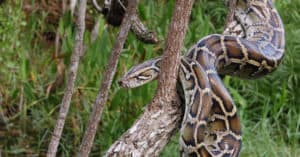Introduction
Tiger serpents are among one of the most widely known and been afraid reptiles in Australia, widely recognized for their striking look and powerful poison. This short article intends to explore the details of the tiger serpent's habitat, distribution, habits, and what one can expect when running into these remarkable creatures. Website link By recognizing where to locate them and just how to navigate potential threats, you can value their duty in the community while guaranteeing your safety.
Tiger Serpent Habitat: Where to Locate Them and What to Expect
Tiger serpents are predominantly located in southeastern Australia, including Tasmania, where they prosper in a variety of environments. Their adaptability enables them to populate diverse terrains such as seaside regions, marshes, meadows, and even city locations.
Geographical Circulation of Tiger Snakes
The geographical reach of tiger serpents expands throughout numerous Australian states. They are especially usual in:
- Tasmania: The Tasmanian tiger snake is just one of one of the most recognized subspecies. Victoria: Discovered near water bodies like rivers and lakes. New South Wales: Liking bushland areas near to water sources. Western Australia: Even more typically seen around swamps and estuaries.
Understanding the geographical distribution is critical for both preservation efforts and public recognition pertaining to experiences with these snakes.
Preferred Habitats of Tiger Snakes
Tiger snakes grow in different environments. Below are some typical atmospheres where they might be found:
Wetlands: They choose marshy or marshy locations where they can access target easily. Coastal Regions: Near coastlines or rocky shorelines offer abundant food resources like fish and amphibians. Forested Areas: Thick brushwood offers shelter from killers while providing hunting grounds.Behavioral Patterns Connected to Habitat
Understanding tiger snake actions within their environments is important for communication monitoring:
- Nocturnal Activity: Tiger serpents tend to be more active during twilight hours (sundown and dawn), making them more difficult to detect during daytime. Territorial Nature: They display territorial habits; thus, it's vital to respect their room if encountered.
This understanding can help minimize undesirable communications in between people and tiger snakes.
Are Tiger Snakes Venomous?
Yes, tiger snakes are without a doubt poisonous. Their poison consists of neurotoxins that can create paralysis or perhaps fatality if untreated.
What Makes Their Venom Dangerous?
The effectiveness of a tiger snake's venom varies depending upon numerous variables:
- Geographic location Individual health Quantity infused during a bite
Symptoms of a Tiger Serpent Bite
Recognizing signs early is critical:
- Pain at the bite site Swelling Difficulty breathing
Immediate clinical focus is important if bitten.
First Help for Snake Bites
Knowing emergency treatment procedures can be lifesaving in case of a snake bite.
First Help Steps for Snake Bites
Stay calm; keep the damaged area still. Call emergency services immediately. Apply a pressure plaster over the bite site. Keep the specific resting up until help arrives.Following these steps can substantially improve results following a snake encounter.


Where Else Can You Encounter Tiger Snakes?
While they're commonly discovered in their all-natural habitats, urbanization has caused increased encounters with humans.
Urban Encounters
Tiger snakes might venture into yards or parks searching for food or water sources.
Precautions When Hiking or Exploring
When checking out areas recognized for tiger serpent environments:
- Wear thick boots Stay on paths Be vigilant
Taking these precautions will certainly help reduce threats while you appreciate nature.
Baby Tiger Snakes: A Special Viewpoint on Growth
Just like grownups, infant tiger snakes are birthed venomous but smaller in dimension. What to do if bitten by a snake
Characteristics of Child Tiger Snakes
- Size: Commonly around 20-- 30 cm when born. Appearance: Sport similar pigmentation as adults but may have lighter bands initially.
Understanding their development assists in appreciating their ecological function from infancy onward.
FAQs about Tiger Snakes
1. Are all tiger snakes venomous?
Yes, all varieties of tiger serpents have venom with the ability of causing serious harm.
2. Just how can I determine a tiger snake?
Look for distinctive banding patterns varying from yellowish-brown to blackish shades along their bodies; adults typically expand in between 1-- 2 meters long.
3. What must I do if bitten by a tiger snake?
Seek immediate clinical focus; use first aid steps as talked about earlier while keeping calm.
4. Do infant tiger snakes posture any danger?
Absolutely! Despite their little dimension, child tiger serpents are still poisonous and can provide bites that call for significant medical attention.
5. Are there any particular habitats I must avoid?
Avoid going through thick underbrush or near stationary water where problems prefer snake visibility throughout warmer months.
6. How do conservation efforts influence tiger serpent populations?
Conservation campaigns focus on environment conservation which straight influences populace stability by ensuring enough food sources and safe breeding locations.
Conclusion
In recap, understanding "Tiger Serpent Habitat: Where to Locate Them and What to Anticipate" not just improves our understanding about these impressive reptiles but additionally enhances our capability to coexist safely with them in shared settings. From acknowledging their favored environments to recognizing just how to respond effectively if bitten, comprehensive knowledge equips us all-- whether we're wildlife lovers or casual hikers-- to appreciate this remarkable facet of Australia's all-natural heritage while prioritizing our safety.
This Additional hints post serves as a substantial overview on whatever pertaining to tiger serpent habitats! Whether you're a passionate traveler or somebody looking simply for info about these creatures, knowing how they interact within their communities-- and how we fit into that picture-- is crucial!